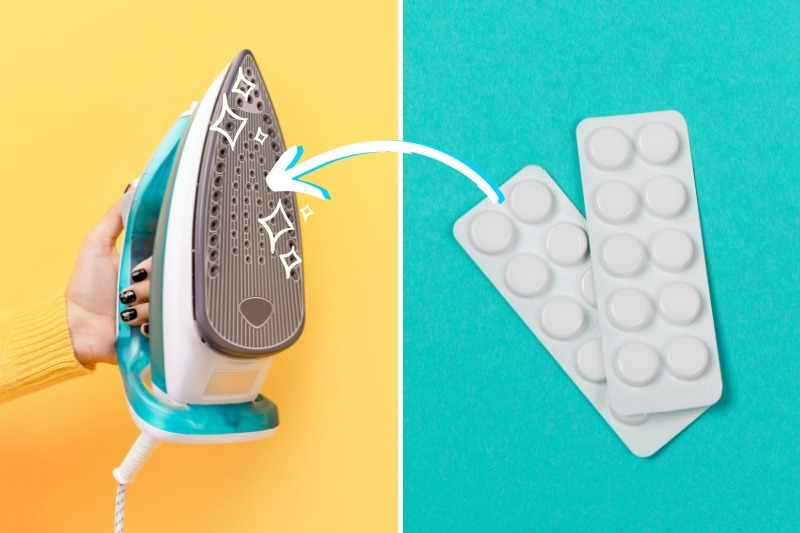A dirty, rusty iron can be quite a headache! The iron won’t look its best, it might not work effectively, and the grotty patches on the soleplate might damage your creased laundry.
Yet, there’s a simple cure! You can use paracetamol to clean the iron’s soleplate.
Find out what you need to do to revive your iron’s soleplate with paracetamol tablets below, and discover how you should clean the rest of your iron too.
How to Clean an Iron’s Soleplate with Paracetamol
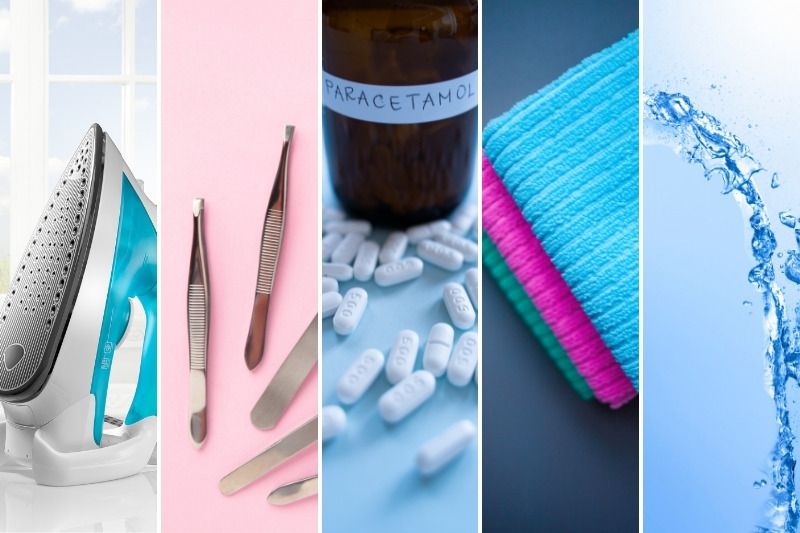
Using paracetamol tablets to clean an iron’s soleplate is a cheap and simple way of maintaining the appliance. Find out how to use these tablets below.
What you need:
- Iron
- Tweezers/tongs
- Paracetamol tablets
- Cloths
- Water
Remember:
- Don’t use paracetamol tablets that have a coating or are in capsule form. If you use these versions of paracetamol, the coating/capsule may leave some residue on the iron’s soleplate and the tablet will not clean away the dirt effectively.
- Don’t use plastic tweezers, as the plastic will melt onto the iron’s soleplate.
- If you’re concerned about using tweezers to hold the tablet in place, you can use wooden tongs instead.
- Keep in mind that rubbing metal tweezers along an iron’s soleplate may cause some scratches to occur, so be careful.
Steps to follow:
Note: The iron will be very hot when you carry out the method below, so take your time and be very careful.
- Get all your tools ready and clear a work space for yourself – ideally, kids and pets should be kept out of the way when you’re treating a hot iron.
- Empty any leftover water from your iron.
- Heat your iron up to its hottest setting.
- Grab your tweezers and pick up a paracetamol tablet.
- Carefully start rubbing the paracetamol tablet over the scorched area(s) on the iron’s soleplate.
- Apply some pressure, but remember that metal tweezers may scratch the surface.
- The paracetamol tablet will start to break down as you work it over the hot iron plate, so grab a new tablet when this starts to happen.
- You might also have to use a clean cloth to wipe away any dirt that’s started to become loose during this process – the iron will be hot, so take care.
- Continue to do this until you’ve cleaned the entire affected area.
- When you’re done, switch the iron off so it starts to cool down.
- Grab a clean cloth and remove the residue that’s been left behind on the soleplate’s surface.
- Fill the iron up with fresh water.
- Start the iron up again.
- When the iron is hot again, start ironing over a piece of cloth. Use the steam feature to clear out the steam holes on the soleplate at this time.
Alternative method:
If you don’t fancy using some sort of tool to rub a paracetamol tablet over an iron’s soleplate, you could lay a cloth on a flat surface, pop some tablets onto the cloth, then iron over them.
The principles of this method are essentially the same as above. However, this method isn’t ideal because you can’t see what you’re actually cleaning and it can take longer. But it is an alternative, and arguably a safer, option you could try out.
Alternative Ways to Clean a Soleplate Without Paracetamol
Here are some other ways you can clean an iron’s soleplate.
1. Self-clean feature
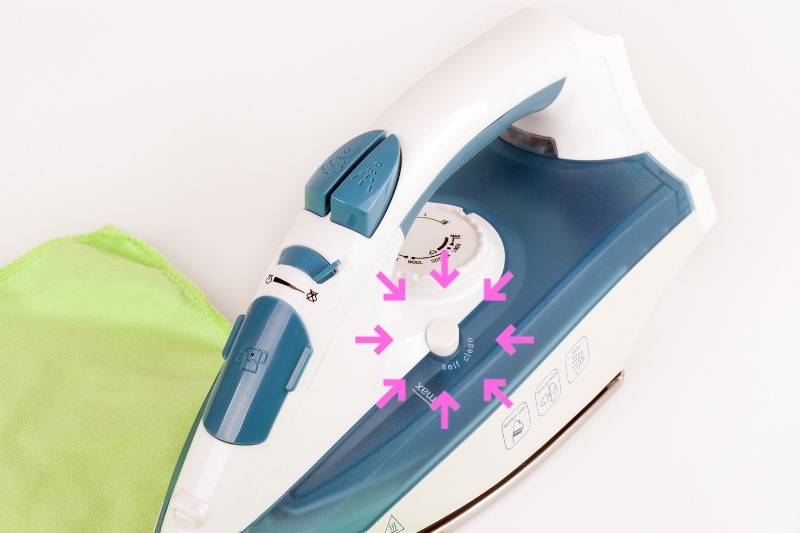
If your iron has a self-clean feature, you should make use of it on a regular basis. Not sure how this works? Just read your user handbook to find out if your iron model actually comes with this feature, and if it does follow the instructions in the book to start this type of clean.
You typically have to fill the water reservoir up, heat the iron up to its hottest temperature, then switch the power off when the maximum temperature has been reached.
Then you drain the water from the tank while holding the ‘self-clean’ button down to activate the self-clean feature.
2. Toothpaste
If your iron soleplate is looking a little worse for wear, a very simple way to revive it is by rubbing some toothpaste onto the affected areas.
When you’re done, you just leave the paste to rest like this for a minute or two, and then you wipe the residue off with a clean cloth.
In addition to this, you’ll need to fill and heat your iron up, then you can activate the steam feature to clean out the holes in the soleplate. This’ll clear out any clogged up toothpaste.
3. Salt and greaseproof paper
Interestingly, a dash of salt can also help to clean up an iron’s soleplate! Simply lay a piece of greaseproof paper on a flat surface, sprinkle salt onto the paper, fire the iron up and then iron over the salt in circles (make sure the iron is warm).
Once you’re done you need to switch the iron off, and when it’s cooled down, you can wipe the soleplate down with a dry cloth.
4. Bicarbonate of soda
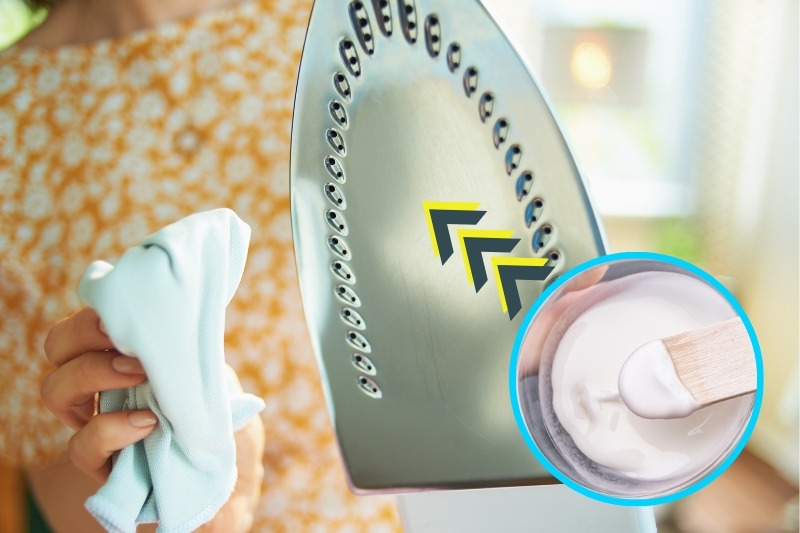
Bicarbonate of soda is traditionally used in the cooking world, but it also has great cleaning properties. One of which is actually cleaning iron soleplates.
Simply mix two tablespoons of bicarb with one tablespoon of water and stir until you get a thick paste-like consistency. Once you’ve got your paste ready you can spread it over the soleplate, but try not to get it into the steam holes.
When you’re done you can leave the paste to rest like this for a few minutes, and then you can wipe away the residue with a cloth.
If you do happen to get the paste in any of the steam holes you will need to remove it before you use the iron again.
How to Clean the Other Parts of an Iron
While the soleplate of an iron will undoubtedly be one of the dirtiest parts of an iron, it does not mean that you should skip cleaning other parts of the iron.
In fact, an unkempt iron may not work as well as it should, so it’s crucial that you maintain it in its entirety.
Other parts to clean include:
- Water reservoir
- Steam holes
- External parts of the iron
- Cable
While it isn’t possible to clean these other sections with paracetamol, you can, in fact, clean them very quickly with a handful of goods found at home, and with minimal effort. Learn more about cleaning an iron below.
Note: For exact guidance on how to clean your particular model of iron you should consult your user guidebook. You might be advised on specific products that you need to buy to clean your iron, so you don’t void your warranty for example.
How to Clean the Water Reservoir
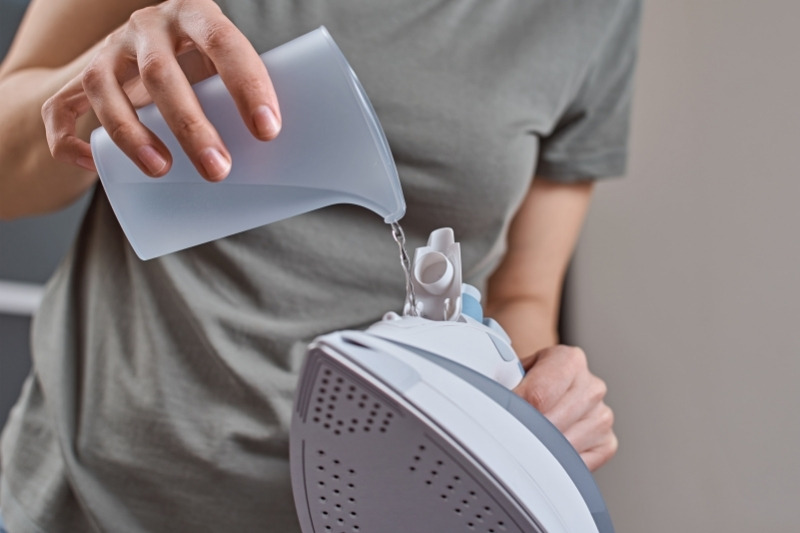
The water reservoir on an iron can be plagued by mineral deposits, and if these troublesome deposits aren’t cleaned away, they can eventually hinder the overall performance of the iron.
To clean the water reservoir all you need to do is:
- Hold the iron in an upright position.
- Put about a quarter of a cup of white vinegar into the water reservoir.
- Fill the iron up to about three-quarters of the way with distilled water.
- The water reservoir should not be completely full.
- Fire up the iron and select a hot temperature.
- Lay out a cloth on a flat surface.
- When the iron is hot, place it on top of the cloth.
- Press the steam button, so steam flows out of the appliance.
- Continue to do this to remove dirt from the steam holes.
- Unplug the iron and leave it to cool down.
- Tip out all the wastewater that is still in the water reservoir (this will dislodge any deposits inside the reservoir itself).
- Refill the water reservoir with more distilled water.
- Start the iron up again and select a hot temperature.
- Lay the iron on a flat cotton surface and press the steam button down multiple times.
- Once you’ve cleared out any leftover dirt, you can unplug the iron and leave it to cool down.
How to Clean the Steam Holes
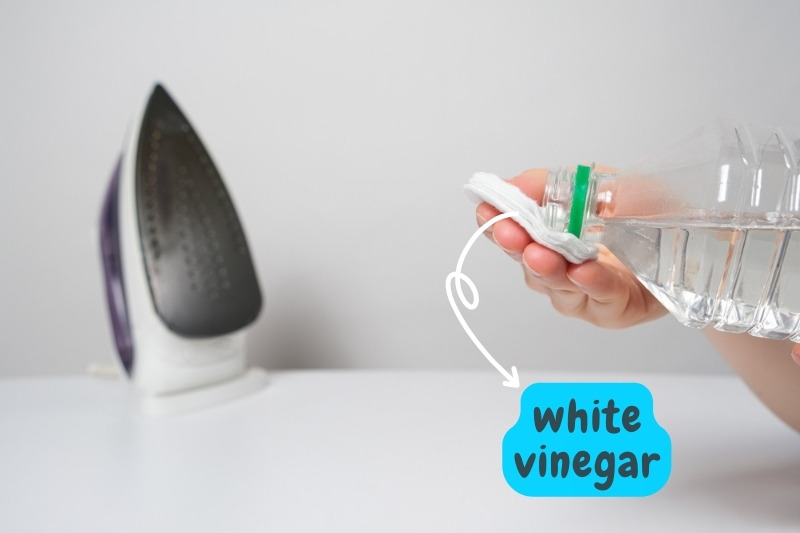
Steam holes get clogged up with mineral deposits, general dirt and fibres on clothes. So, cleaning out these holes is essential.
To clean the steam holes all you need to do is:
Follow the steps above for ‘How to clean the water reservoir’. And then grab a small cotton bud or a toothpick and gently remove the gunk from the holes.
A combination of white vinegar and water loosening the mineral deposits internally, and actively unclogging the holes with a pick externally will improve how well the steam holes work.
In addition to this and for more stubborn deposits, you could also soak a cloth in white vinegar and then pop your iron face down on this cloth for half an hour.
The white vinegar from the cloth will help to loosen up mineral deposits found in the steam holes. You can then clean the holes with a cotton bud dipped in white vinegar.
Tip: Try your best to clean each and every steam hole to the same standard, as this will allow the steam to be evenly distributed over your wrinkled clothes. If some of your steam holes are left clogged the steam won’t be able to exit them effectively. So, some patches of your clothes might look better ironed than others.
How to Clean the External Parts of an Iron
The main body of an iron, the part that comes into contact with your hands, is probably filled with more germs and bacteria than you think. So, it’s imperative that you clean this section from time to time.
To clean the exterior all you need to do is:
- Make sure the iron is off and is cold.
- Soak a cloth in some warm soapy water (mix water with washing up liquid).
- Wring out the cloth and remove as many suds as you can, if there are any.
- Then wipe the external areas of the iron down.
- Don’t clean the water reservoir with this cloth.
- Grab a new cloth and hold it under some warm water.
- Wring out this cloth.
- Wipe the external areas down again (this will remove any excess residue).
- Dry the areas down with a dry cloth.
- As an additional step you could clean the handle area with an antibacterial wipe, just to make the area extra clean.
How to Clean the Iron’s Cable
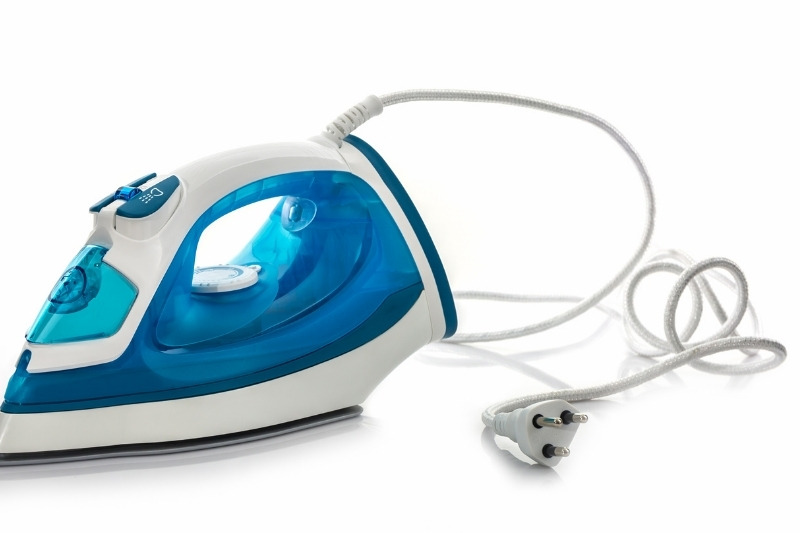
Cables can pick up all kinds of dirt when they’re scattered along the floor. And while a messy cable isn’t necessarily the end of the world, a clean cable can make an appliance look well kept, and it’s also far easier to pick up on potential cable problems (like fraying/splits) on unsoiled cables, in comparison to grubby ones.
To clean the cable all you need to do is:
- Make sure the iron is off and is cool.
- Soak a cloth in some warm water and washing up liquid.
- Wring the cloth.
- Then rub the cloth along the cable to clean it.
- Allow the cable to dry before plugging the iron in again.
- Don’t wet the plug end!
Do You Need to Clean an Iron?
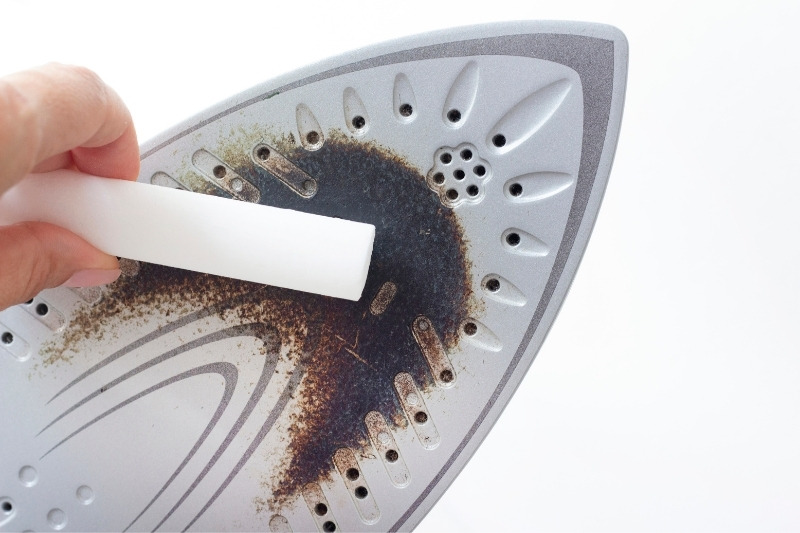
Yes, you should clean your iron on a regular basis. Why?
- To prevent a build of limescale in the iron.
- An iron that is unkept might not work properly.
- A soleplate that’s marked or grotty may not glide over fabric very smoothly, and this could lead to you snagging the material.
- If the steam holes on an iron are blocked, limited steam will come out of the holes as you iron your laundry. And given the fact that steam is crucial when it comes to ironing creases out of material, your items may not be wrinkle-free by the end of the session if the holes are clogged.
- If you leave old oils on the soleplate, they will transfer onto other items that you plan on ironing if you don’t clean them off.
- You may see some mineral deposits being left behind on your laundry after you’ve ironed them, if you don’t maintain your iron.
A quick recap:
You should clean an iron’s soleplate to get rid of any unwanted dirt, to remove any scorch marks, oils and sticky marks as soon as possible. Failing to do this will impact how the iron works, and if the iron is dirty/damaged this could harm the material you’re ironing too.
In addition to this, you need to keep the steam holes free from grime and to remove limescale deposits. You can do this every few months, but if you iron frequently, you might have to clean the steam holes out more often.
You also need to clean the water reservoir out, so you don’t get a build-up of limescale in the tank. And you need to do this every one to four months, but perhaps more frequently if you iron a lot.
It’s also worth giving the iron’s exterior a clean every few weeks. This will help to remove lingering bacteria from the surface.

Bethan has a passion for exploring, reading, cooking and gardening! When she’s not creating culinary delights for her family, she’s concocting potions to keep her house clean!
